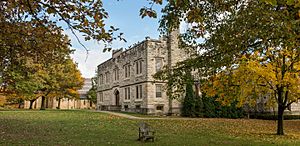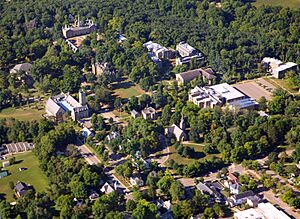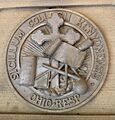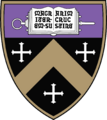Kenyon College facts for kids
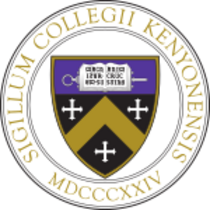 |
|
| Latin: Collegii Kenyonensis | |
| Motto | Magnanimiter Crucem Sustine (Latin) |
|---|---|
|
Motto in English
|
"Valiantly bear the cross" |
| Type | Private liberal arts college |
| Established | 1824 |
| Endowment | $560 million (2023) |
| President | Julie Kornfeld |
|
Academic staff
|
213 |
| Undergraduates | 1,877 |
| Location |
,
,
United States
|
| Campus | Rural, 1,000 acres (400 ha) including a 380-acre (150 ha) nature preserve |
| Newspaper | The Kenyon Collegian |
| Colors | Purple and White |
|
Sporting affiliations
|
NCAA Division III – NCAC |
| Moniker | Owls |
 |
|
|
Kenyon College
|
|
| Location | Gambier, Ohio |
| Built | 1824 |
| Architect | Multiple |
| Architectural style | Gothic Revival, Greek Revival |
| NRHP reference No. | 75001447 |
| Added to NRHP | December 6, 1975 |
Kenyon College (/ˈkɛnjən/ KEN-yən) is a private liberal arts college in Gambier, Ohio, United States. It was founded in 1824 by Episcopal Bishop Philander Chase. It is the oldest private institution of higher education in the state of Ohio and enrolls approximately 1,800 undergraduate students. Students choose from over 50 majors, minors, and concentrations, including self-designed majors.
The college is located on a hill overlooking the Kokosing River and neighbors Mount Vernon, Ohio. Its 1,000-acre (400 ha) campus is set in rural surroundings that host seven ecosystems. There are more than 120 student clubs and organizations. Kenyon athletes are called Owls and compete in the NCAA Division III North Coast Athletic Conference. Kenyon College is accredited by the Higher Learning Commission.
Contents
History
Founding

After becoming the first Episcopal Bishop of Ohio in 1818, Philander Chase found a severe lack of trained clergy on the Ohio frontier. He sailed to England and solicited donations from George Kenyon, Lord Gambier, and the writer and philanthropist Hannah More. The college was incorporated in December, 1824. Dissatisfied with the original location of the college in Worthington, Chase purchased 8,000 acres (3,200 ha) of land in Knox County (with the Mount Vernon lawyer Henry Curtis), and reached what he would name Gambier Hill on July 24, 1825.
The Kenyon Review
Kenyon's English department gained national recognition with the arrival of the poet and critic John Crowe Ransom in 1937 as professor of poetry and first editor of The Kenyon Review, a literary journal. During his 21-year tenure, Ransom published work by writers Allen Tate, Robert Penn Warren, William Empson, Mark Van Doren, Kenneth Burke, and Delmore Schwartz, as well as younger writers Flannery O'Connor, Robert Lowell, and Peter Taylor, among others. It was an influential literary magazine during the 1940s and 1950s.
The Kenyon Review hosts a two-week summer writing workshop on campus for high-school students. The Review sponsors an annual summer writers workshop for adults. The Kenyon Review also operates the KR Associates Program, allowing Kenyon students to gain experience in literary editing, publishing, and programming. Student associates work with Kenyon Review staff in manuscript evaluation, publicity and marketing, and event planning, among other creative and editorial projects.
Academics
Kenyon is a four-year liberal arts college. There are 18 academic departments, 14 interdisciplinary programs, and more than 50 majors, minors, and concentrations. Kenyon requires students to take classes in each of the four academic divisions: fine arts, humanities, natural sciences, and social sciences. In addition, students must study a foreign language. Its most popular majors, by 2021 graduates, were: English, Economics, Psychology, Political Science, and Biology. The academic year follows a schedule of two four-course semesters, as well as research opportunities in the natural sciences, humanities, social sciences, and fine arts during the summer.
Kenyon's faculty includes over 200 full-time professors, with 99% of faculty holding a Ph.D. or other terminal degree in their field. All courses are taught by professors, with a student-to-faculty-ratio of 10:1.
Kenyon claims to offer more than 190 study abroad programs in 50 different countries. There is a program at the University of Exeter and one in Rome.
Kenyon's Center for the Study of American Democracy (CSAD), established in 2007, organizes conferences and seminars with the goal of promoting nonpartisan civic and political discourse. Students can join the Center as Associates, serving as student advisors, organizing events, and encouraging greater participation on campus in the center's programs. CSAD was funded through a grant from the National Endowment for the Humanities.
The Gund Gallery, a 31,000 square feet (2,900 m2) visual arts center and exhibition space, was opened in 2011. It hosts lectures, public programming, and exhibitions from traveling shows and its permanent collection.
Admissions
Admission to Kenyon is considered "most selective" by U.S. News & World Report.
For the class of 2022 (enrolling fall 2018), Kenyon received 6,152 applications, accepted 2,204 (35.8%), and enrolled 539. For enrolled first-year students the middle 50% range of SAT scores was 640–730 for critical reading and 640–740 for math, while the ACT composite range was 29–33; the average GPA was 3.94.
Rankings
| USNWR Liberal Arts College | 39 |
|---|---|
| Washington Monthly Liberal Arts | 92 |
| Forbes | 244 |
In 2006, Newsweek selected Kenyon College as one of twenty-five "New Ivies" on the basis of admissions statistics as well as interviews with administrators, students, faculty members, and alumni. Additionally, it was also listed in Greene's list of Hidden Ivies in 2000. Time's 2018–2019 "Best Colleges in America" report ranked Kenyon as the 214th best college in the country.
In the 2023 U.S. News & World Report rankings, Kenyon was tied for the No. 39 liberal arts college in the United States. In the 2022 Forbes rankings, Kenyon was ranked 40th among liberal-arts colleges and 176th among 650 colleges and universities in the United States. In 2022, CollegeSimply ranked Kenyon as the 2nd best institution of higher education in Ohio and the 61st best college or university overall.
Previously, Kenyon gained national recognition for LGBTQ inclusion. It was ranked as one of the best campuses for LGBTQ students in the country in both 2020 and 2021. It did not retain this ranking in 2022.
Although Kenyon is often ranked favorably, some methods that rank colleges based on their calculated return on investment (ROI) have been critical of Kenyon's value. The 2018 Payscale College ROI Report ranked Kenyon as the 983rd best value college in the country.
Athletics
Kenyon's sports teams, which compete in the North Coast Athletic Conference (NCAC), were referred to as the Lords and Ladies until 2022 when a new nickname, the Owls, was adopted. At various points in the past, the teams were also known as the Mauve, the Purple, the Purple and White, the Hilltoppers, and simply as Kenyon.
The men's swim team, in NCAA Division III, claims to have won, from 1980 through 2010, a record 31 consecutive NCAA national championships as well as consecutive titles between 2012 and 2015 for a total of 34 program titles. The women's swim team has won 24 non-consecutive titles of their own since 1984, the most recent being in 2022.
In 2006, Kenyon opened the Kenyon Athletic Center (KAC), a 263,000-square-foot (24,400 m2) building. Field hockey, football and men's lacrosse are played at McBride Field which has a seating capacity of 1,762.
In 2019, Kenyon was one of the first National Collegiate Athletic Association (NCAA)-member colleges to participate in the organization's LGBTQ OneTeam Program, which launched in fall 2019.
Traditions
Kenyon is Ohio's oldest private college with some traditions dating back almost 200 years. All incoming students are expected to take the Matriculation Oath and sign a Matriculation Book that dates back over a century.
Another tradition is the "First-Year Sing." Each year, entering first-years gather on the steps of Rosse Hall to sing Kenyon songs before they are officially part of the Kenyon community. On the day before Commencement, seniors gather on the steps of Rosse Hall to sing the same songs again.
Kenyon students avoid stepping on the college seal in the entrance hall of Peirce Dining Hall. Tradition holds that if someone steps on the seal, they will not graduate from the college.
The Church of the Holy Spirit, one of Kenyon's oldest structures, features a 10-bell set of chimes which ring the traditional Westminster Quarters. The bells, installed in 1879, are rung manually in the belltower each Friday by a campus group known as the Kenyon Pealers.
Whenever a new president begins their time at the college, candles are lit in every window of Old Kenyon, as a sign of welcome. Additionally, a bell hangs in the steeple of Old Kenyon and is only rung when a new president is inaugurated, as well as having been rung when the United States is no longer engaged in war and when the Kenyon football team wins a home game. Kenyon has had twenty-five presidents (including acting or interim appointments); former president S. Georgia Nugent was Kenyon's first female president, and former president Sean Decatur was Kenyon's first African-American president. The president's academic regalia is a purple gown with four velvet chevrons on each sleeve signifying the office of the president, a college seal medallion with the names of each Kenyon president on the chain links, and a purple beefeater cap. The purple beefeaters cap is also worn by college trustees at ceremonies.
The college's official song is "The Thrill." However, "Kokosing Farewell" is more often sung at ceremonies. "Kokosing Farewell," sung to the tune of the 1870 hymn "The Day Thou Gavest, Lord, Is Ending," is the traditional closing number for concerts of the Kenyon College Chamber Singers.
The college has maintained a tradition of formality at ceremonies. During the annual commencement ceremony, the conferring of degrees to the class and announcement of each individual student's degree of Bachelor of Arts is done entirely in Latin. Kenyon's diplomas are also written entirely in Latin.
Shield and seal
The first Kenyon seal was designed no later than 1842 and contained a book, a cross, a scroll, a telescope, and a scientific apparatus surrounded by the words "Sigillum Collegi Kenyonensis" and "Ohio Resp". Since the second and current seal was introduced, the first seal has rarely been used.
Kenyon's second and current shield is derived from the coat of arms of Lord Kenyon, one of the college's first and most prominent benefactors. The shield consists of a chevron, three crosses, a book inscribed with the college's motto (as well as the Kenyon family's motto) magnanimiter crucem sustine ("valiantly bear the cross"), resting upon a bishop's staff, representing the college's founder, Bishop Philander Chase. The shield has become a widely used symbol for the college. A version of the shield that replaces the book and staff with "Kenyon" in block letters while the chevron and crosses remain has become the symbol for the college's athletic teams.
In 2011, American clothier Ralph Lauren discontinued production of a necktie depicting the Kenyon shield after it was found they did not license the rights from the college.
The Bexley Seminary had its own shield until its dissociation from the college in 1968. While it contained the book, motto, and bishop's staff of the Kenyon shield, an eagle and ermine pattern blazoned the lower portion of the shield.
Sustainability
Kenyon College has undertaken a number of sustainability initiatives, including a recycling system upgrade, a biodiesel project, a computer lab conversion to double-sided printing, the distribution of green living guides, as well as the creation of a dining hall composting system that diverts 6,000 pounds of waste from the landfill per week. Additionally Kenyon's cafeteria is committed to serving local food and has become a leader among college cafeterias in the country. Students partnered with administrators and professors to complete a campus energy audit for the past three years, as well as a carbon footprint calculation. Kenyon Green Alumni was founded to connect graduates "with a professional interest in the environment." The college recently received a "C" grade on the 2010 College Sustainability Report Card, compiled by the Sustainable Endowments Institute.
The Kenyon Farm is a mixed crop-livestock operation providing produce to local markets and giving students the opportunity to gain practical skills and knowledge for small-scale farming operations.
Ivy, which once covered some buildings on the Kenyon campus, but damages stonework, has been eradicated.
Notable alumni

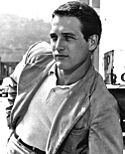
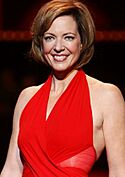


Notable alumni of Kenyon College include:
- U.S. Supreme Court Justices David Davis (1832), Stanley Matthews (1840), and William Rehnquist (attended, 1946)
- U.S. Secretary of War Edwin M. Stanton (1834)
- Abolitionist and women's rights activist John Celivergos Zachos (1840)
- U.S. President Rutherford B. Hayes (1842)
- Poet Robert Lowell (1940)
- Writer Peter Taylor (1940)
- Novelist William H. Gass (1947)
- Swedish Prime Minister Olof Palme (1948)
- Actor Paul Newman (1949)
- Comedian Jonathan Winters (attended, 1950)
- Novelist E.L. Doctorow (1952)
- Poet James Arlington Wright (1952)
- Molecular biologist Harvey Lodish (1962)
- Architect Graham Gund (1963)
- Cartoonist Jim Borgman (1976)
- Matthew Winkler (journalist) (1977)
- Professor of Law Amos N. Guiora (1979)
- Cartoonist Bill Watterson (1980)
- Author Donovan Webster (1981)
- Actor Allison Janney (1982)
- U.S. Congressman Zack Space (1983)
- Author Laura Hillenbrand (1989)
- U.S. Ambassador to Ukraine Bridget A. Brink (1991)
- Football coach Chris Creighton (1991)
- Author Jenna Blum (1992)
- Politician Leopoldo Lopez (1993)
- Actor and filmmaker Josh Radnor (1996)
- U.S. Congresswoman Lizzie Pannill Fletcher (1997)
- Lawyer and climate activist Colette Pichon Battle (1997)
- Basketball coach Shaka Smart (1999)
- Author John Green (2000)
- Author and filmmaker Ransom Riggs (2001)
- Political strategist Sarah Longwell (2002)
- Entrepreneur Juul James Monsees (2002)
- U.S. National Security Council spokesperson Tommy Vietor (2002)
- Astrophysicist and artist Nia Imara (2003)
- Musician Nicholas Petricca (2009)
- Musician Evan Stephens Hall (2011)
- Musician Justin Roberts (1992)





